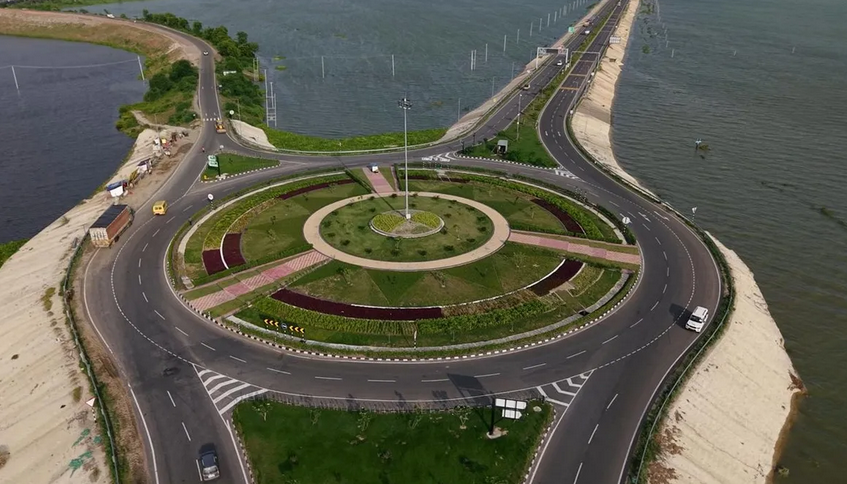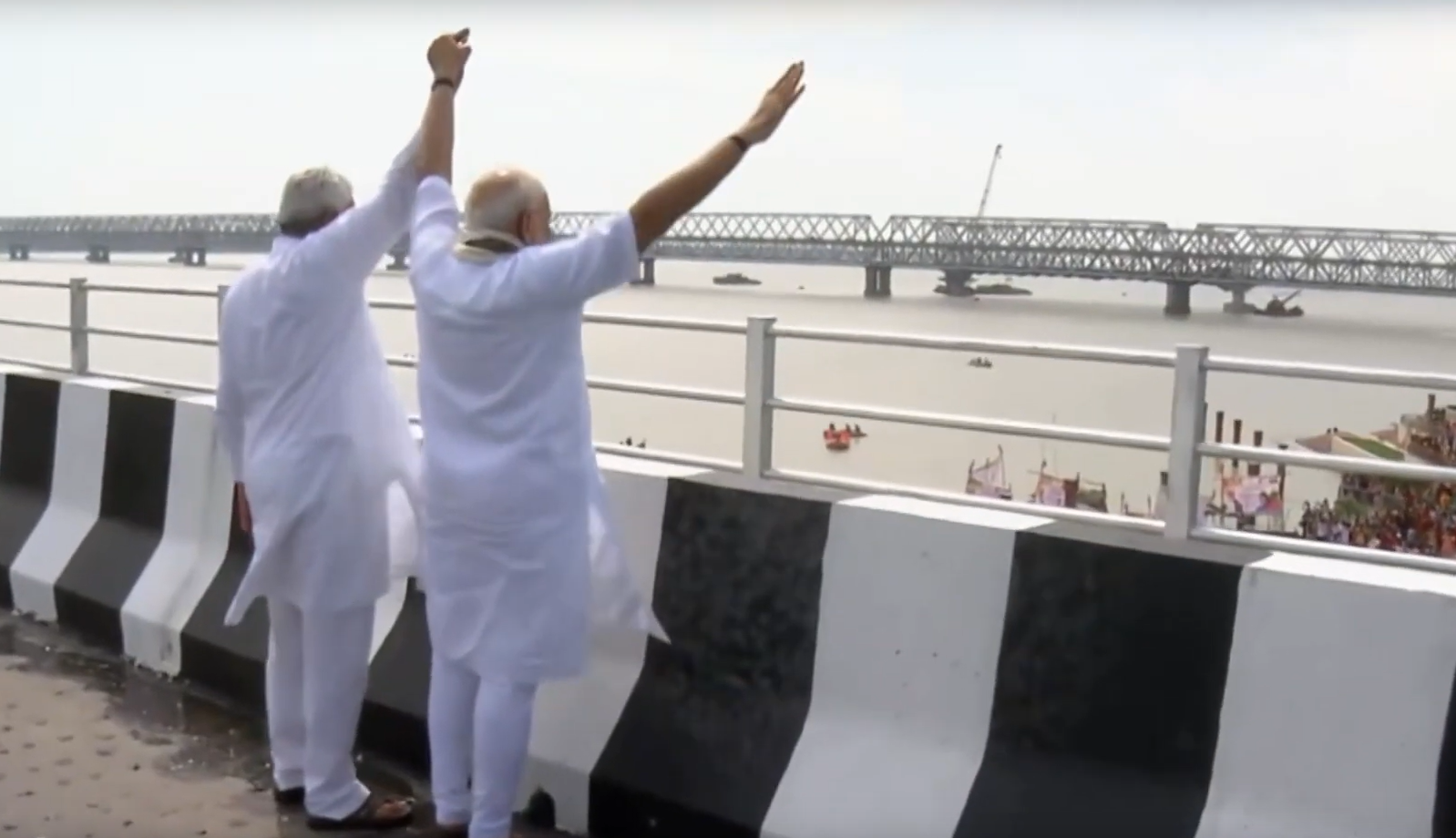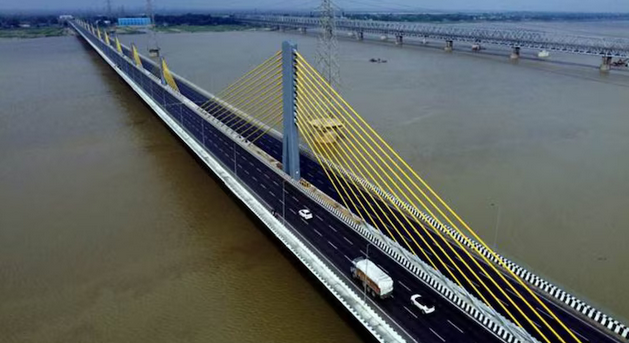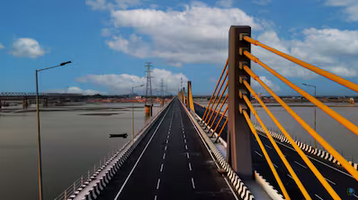Aunta Simaria Bridge Inauguration: PM Modi Opens 6-Lane Ganga Link; Kolkata Metro Expanded | Full Details
Prime Minister Narendra Modi today inaugurated the Aunta–Simaria Ganga Bridge on NH-31, a 1.86-km, six-lane highway bridge designed to directly connect Mokama (Patna district) with Begusarai, easing one of Bihar’s most critical north–south bottlenecks. Including approaches and interchanges, the total project length is ~8.15 km, executed under NHAI with an outlay of ~₹1,870 crore. The bridge sits parallel to the aging Rajendra Setu and is engineered to handle heavy traffic that previously faced long detours.
The Bihar leg was part of a broader day-long tour spanning Bihar and West Bengal, where the PM also launched and dedicated projects worth ~₹13,000 crore in Gaya and flagged off new Kolkata Metro sections, including the long-awaited airport link, marking one of the city’s biggest urban mobility upgrades in decades.

What Happened Today – At A Glance
- Bridge Inauguration (Bihar): PM Modi opened the Aunta–Simaria 6-lane Ganga bridge on NH-31, built at a cost of ~₹1,870 crore, creating a high-capacity corridor across the Ganga and offering a dependable alternative to the strained Rajendra Setu.
- Connectivity Boost: The new link cuts 100+ km detours previously imposed on heavy vehicles, reducing travel time and logistics costs while decongesting parallel routes. It also improves access to Simaria Dham, a key pilgrimage site associated with poet Ramdhari Singh ‘Dinkar’.
- Bihar Package: From Gaya, the PM launched and dedicated projects in power, roads, health, water & urban development totaling ~₹13,000 crore, signaling a coordinated infrastructure push.
- West Bengal Leg: In Kolkata, the PM inaugurated three metro stretches, including the Noapara–Jai Hind Bimanbandar (Airport) link and the final East-West (Green Line) completion, with services commencing per Metro Railway schedules. An elevated Kona Expressway foundation stone was also laid.
The Aunta Simaria Bridge: Engineering, Design & Location
Where it sits: The bridge spans the Ganga between Aunta (Patna side) and Simaria (Begusarai side), forming the centerpiece of the Aunta (Mokama)–Simaria (Begusarai) 4L/6L section on NH-31. The alignment is deliberately parallel to Rajendra Setu, offloading it and creating a modern, high-speed, high-capacity river crossing for through traffic and freight.
Key specs you should know:
- Main bridge length: ~1.86 km; six lanes.
- Total project length: ~8.15 km including approaches, grade separators, and junction improvements.
- Cost: ~₹1,870–1,871 crore (government estimates and press releases align in this range).
- Corridor: NH-31, a vital east-west artery in Bihar’s road grid.
- Mode: Implemented under NHAI, with details listed on its project portal.
Structure type & design language: The bridge employs a wide, high-capacity superstructure suited to six lanes with median and shoulders, optimized for uninterrupted highway speeds and heavy-vehicle loading. Industry notes highlight extradosed/cable-supported segmental engineering features, enabling longer spans over a wide river course while balancing aesthetics, durability, and lifecycle cost.

Why This Crossing Matters
1) North–South Bihar, Finally On A Shorter Arc
With heavy trucks earlier diverted away from the old Rajendra Setu, long detours exceeding 100 km had become routine, wasting fuel, time, and money. The new bridge restores a direct, compliant route for freight and long-haul traffic between districts such as Begusarai, Supaul, Madhubani, Purnea, Araria (north), (south). Logistics planners expect shorter cycle times and lower operating costs across FMCG, construction materials, agri-produce, and e-commerce.
2) Relief For Rajendra Setu & Regional Congestion
The seven-decade-old Rajendra Setu struggled with rising demand and load restrictions. By channeling through-traffic onto a modern six-lane facility, the Aunta–Simaria link will decongest approaches and improve safety across the Ganga crossing zone, benefiting local commuters and long-distance freight alike.
3) Cultural & Pilgrimage Access
The bridge improves last-mile access to Simaria Dham, a major Kalpwas site and the birthplace of Ramdhari Singh ‘Dinkar’, facilitating religious tourism, trade, and seasonal footfall management. The spillover: better livelihoods for local businesses and services.
The Bihar Announcements: What Else Was Launched From Gaya

From the stage in Gaya, the PM laid foundation stones and inaugurated multiple projects cutting across sectors, power generation and evacuation (including the 660 MW Buxar unit), health, urban development, water supply, roads, and tourism (notably the Buddha Circuit). The basket of works totaled around ₹13,000 crore and is pitched as a comprehensive capacity build-out to support industry, services, and tourism.
Politically and economically, the Gaya announcements frame Bihar’s push for reliable power, urban amenities, and faster road connectivity, the trifecta that tends to correlate with job creation, private investment, and district-level growth.
Kolkata Metro: Three New Stretches, Airport Link, And A Network Effect
The West Bengal leg centered on a transformational metro expansion in Kolkata:
- Noapara–Jai Hind Bimanbandar (Airport) link: Kolkata finally gets a direct metro connection to the airport, a leap that most global cities deem essential for efficient urban mobility.
- East–West (Green Line) completion: The through-run from Sector V to Howrah Maidan via the Esplanade–Sealdah link closes a long-pending gap, promising 32-minute end-to-end timings per the initial operations plan.
- Additional corridor openings on the Orange/Yellow axes extend reach into high-demand residential and business catchments.
Metro Railway has issued service start timings and a phased operations plan, including weekday operating windows for the new corridors. The PM also laid the foundation for an elevated Kona Expressway upgrade to smooth out Howrah–Kolkata traffic.
Why this matters:
- Intermodality: Direct airport connectivity sharply reduces transfer friction for air travelers and airport staff.
- Network effect: Completing the East–West spine creates new shortest paths across the city, cutting surface congestion and travel time variability.
- Economic spillovers: Better labor market access, higher retail footfalls around stations, and rising property values typically follow metro upgrades.
Travel Time, Freight Economics & Daily Life: What Changes First
For long-haul and regional freight in Bihar:
- Eliminating the 100+ km detour can save hours per trip, improve fleet utilization, and lower per-tonne freight costs.
- Fuel savings and reduced maintenance (thanks to fewer congested stop-starts) strengthen trucking margins important for MSME transporters who carry agri-produce, cement, steel, and FMCG consignments.
For daily commuters:
- The bridge promises a smoother, safer crossing at consistent speeds, shrinking Begusarai–Patna commute times and improving reliability for students, office-goers, and small businesses.
- In Kolkata, airport trips move onto a predictable timetable; the East–West through-run reduces the need for long surface hops between Sealdah, Esplanade, and Howrah, unlocking time for households and boosting productivity.
Project Timeline & Governance Notes
- Foundation stone: The PM previously laid the foundation for the Aunta–Simaria NH-31 section (including the six-lane bridge) in 2017, with implementation overseen by NHAI.
- Delivery: Following years of construction across monsoon cycles and riverine windows, the bridge reached completion and has now been inaugurated.
- Mode & oversight: NHAI’s project portals list Aunta–Simaria including Ganga Bridge in the Begusarai PIU, with details on scope, lanes (4L/6L), and clearances.

Local Stakeholders & On-Ground Readiness
Traffic management:
- Expect temporary lane discipline measures and enforcement in the early days to set safe driving behavior across the new bridge.
- Wayfinding/signage on both banks is critical to prevent last-minute lane changes and to distribute traffic appropriately toward NH-31 feeder routes.
Emergency response & maintenance:
- With higher speeds and heavier vehicles, on-bridge incident response (patrols, tow, ambulance linkages) and routine maintenance will determine real-world uptime and safety.
Pilgrimage facilitation:
- For Simaria Dham/Kalpwas peaks, local authorities may recalibrate diversions, pedestrian management, and riverfront traffic loops to leverage the new capacity.
The Day’s Political & Economic Signaling
Development narrative: The back-to-back inaugurations across Bihar and West Bengal knit a familiar national story, connectivity first, services next. For Bihar, north–south cohesion is a structural requirement for industrial logistics (petro-chem, dairy, agro-processing) and urban jobs. For Kolkata, the airport link and East–West completion bring the metro closer to a genuine, citywide rapid-transit web.
Elections & optics: The Bihar leg also featured rallies and addresses from which governance, anti-corruptionand infrastructure were amplified to the base. Regardless of politics, the asset-side gains from today’s projects are tangible and measurable in tons moved, minutes saved, and rupees saved.
Conclusion
The inauguration of the Aunta–Simaria Bridge in Bihar and the expansion of Kolkata Metro mark two landmark moments in India’s connectivity push. On one hand, the six-lane Ganga bridge eliminates a century-old bottleneck by restoring seamless north–south road connectivity, slashing travel time, and strengthening the logistics backbone of Bihar. On the other hand, the metro upgrades in Kolkata, including the long-awaited airport link and completion of the East–West corridor, bring the city closer to a world-class rapid transit system.
Together, these projects highlight how infrastructure investment translates directly into growth, cheaper freight, smoother commutes, more tourism, stronger local economies, and greater national integration. For Bihar, it’s about uniting both sides of the Ganga and empowering trade. For West Bengal, it’s about giving Kolkata the urban mobility it has long demanded. And for India, it’s another step towards bridging distances and building opportunities.
The day’s message was clear: connectivity is not just about roads, bridges, and metros, it’s about unlocking potential for millions of people whose lives become faster, easier, and more hopeful when infrastructure meets ambition.
For more live news, in-depth explainers, and infrastructure updates, follow Vishwa Khabar and never miss a story that shapes your journey!
Q1) Is the Aunta–Simaria bridge fully open to all categories of vehicles?
Yes, the six-lane highway bridge on NH-31 is inaugurated as a full-fledged highway crossing designed for heavy vehicles, addressing prior detours caused by restrictions on the old Rajendra Setu. Follow NHAI/traffic police advisories for any phased operations or temporary controls in the initial days.
Q2) How much time will this save for freight movement?
Routes that earlier required 100+ km detours (especially for trucks) now have a direct, compliant crossing, translating into significant time and fuel savings depending on origin–destination pairs and congestion at approaches.
Q3) What does the Kolkata Metro expansion change for airport users?
The Noapara–Jai Hind Bimanbandar stretch creates the first direct metro link to the airport, shifting many trips from surface traffic to rail and stabilizing travel times, especially in peak hours. Revenue services are rolling out per the Metro Railway’s notified timings.
Q4) What is the total cost and length of the Aunta–Simaria project?
The main bridge is ~1.86 km; the overall project, including approaches, is ~8.15 km. The project cost is around ₹1,870–1,871 crore as per official communication and reputable media summaries.
Q5) Which agency executed the bridge?
The project has been implemented under NHAI, with details hosted on its project portal (Aunta–Simaria, including Ganga Bridge).